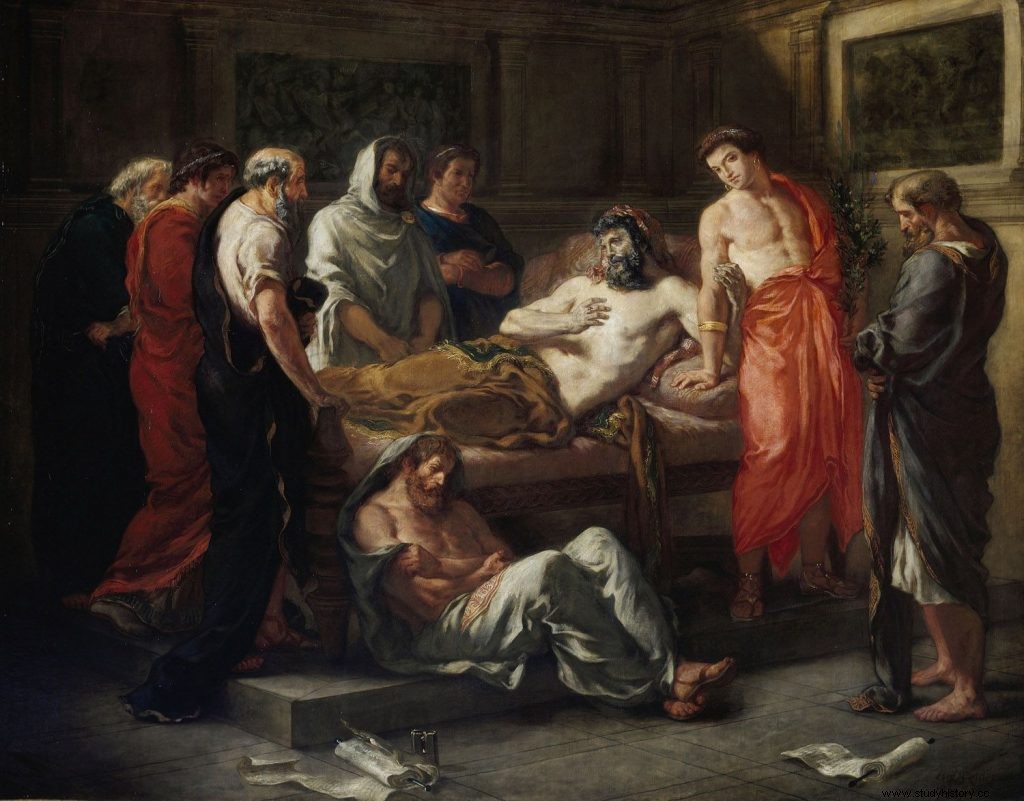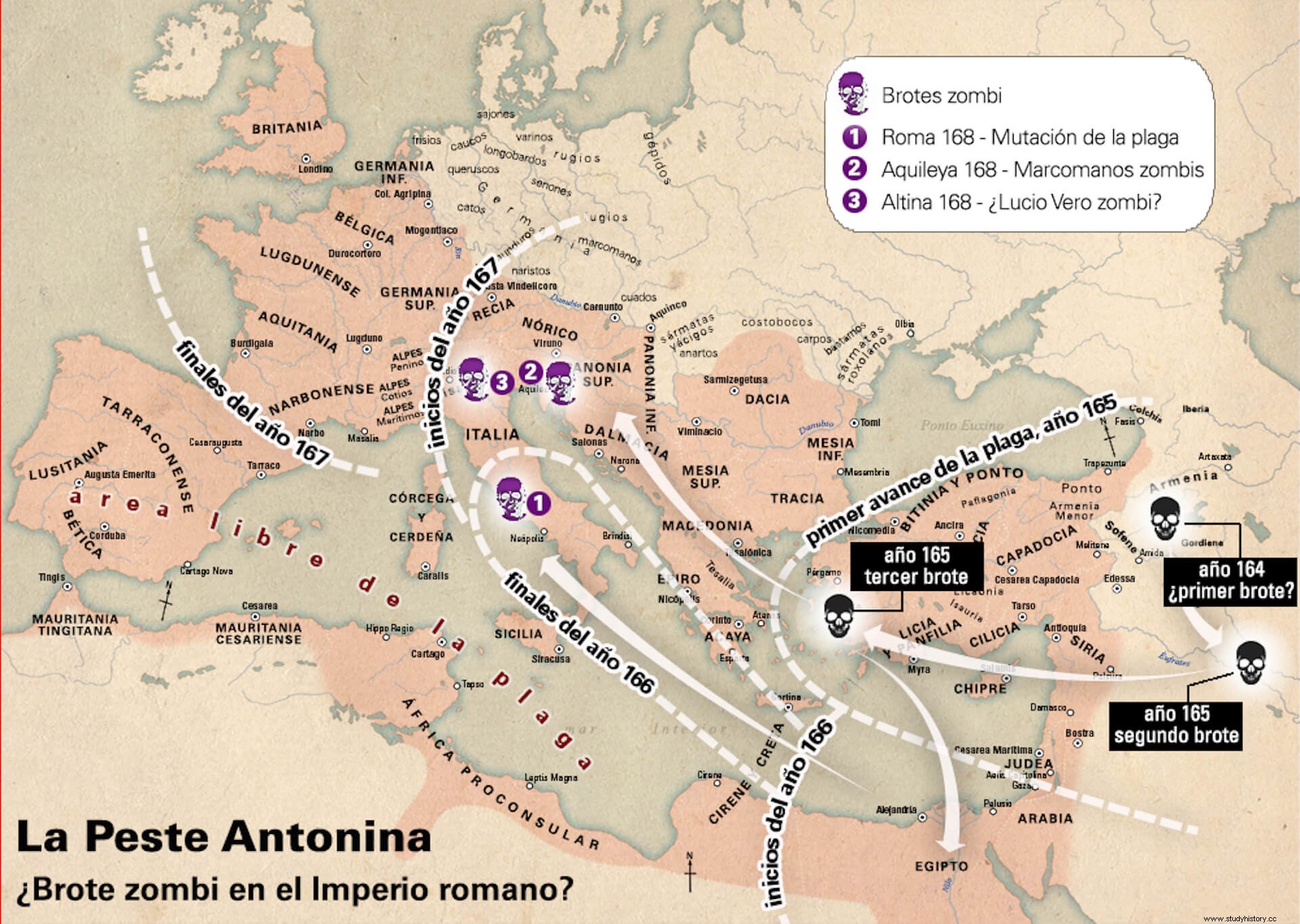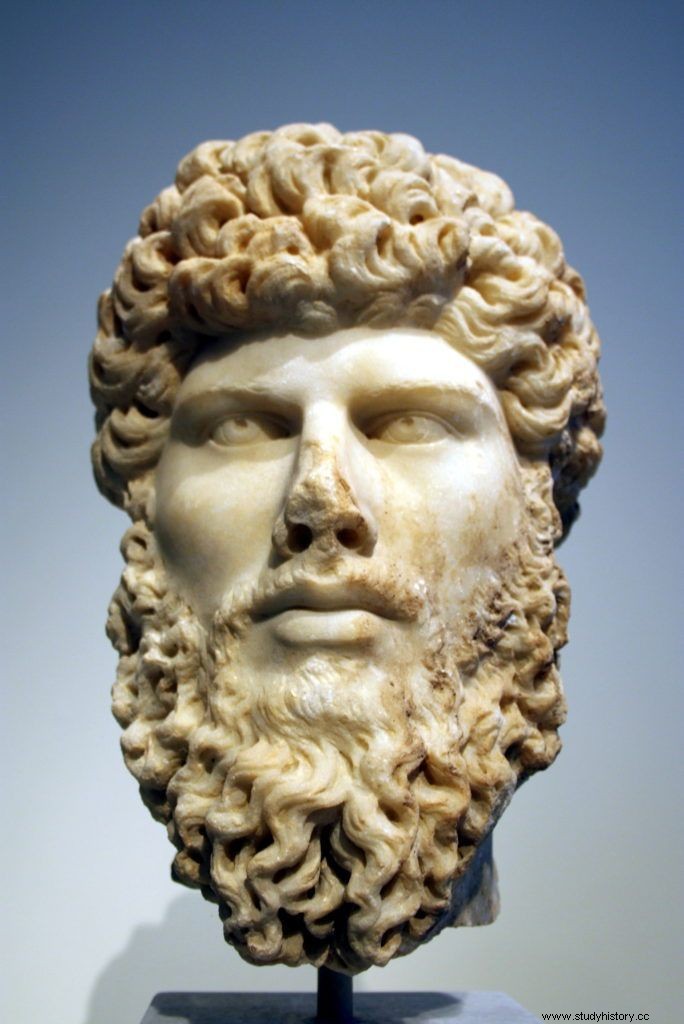According to Dion Cassius (LXX.3.1), the Roman troops would have already suffered the plague in 164 AD. in Armenia, but for Lucian of Samosata (Quomodo Hist . . . . conscr . . . . 15) the outbreak of pestilence would have originated in Ethiopia, whence it passed into Egypt, to then propagate into Asia, reaching in 165-166 Seleucia on the Tigris. This city was sacked by the troops ofLucio Vero , co-emperor with Marcus Aurelius and that from 162 he fought against childbirths, and as a consequence the plague spread among his legionnaires. Another version is the one that gives the biography of Lucio Vero in the Augustan History (SHA., Vita Verus , VIII.1; cf . . . . Amiano Marcelinus, Hist . . . . XXXI.6.24):

The Roman army, struck by the plague, was there of withdrawing from Mesopotamia and a peace treaty was precipitately agreed with the Parts. But when the Rhineland and Danubian units that had participated in the campaign returned to their bases in Europe, they took with them the miasma, which spread rapidly, leaving a wake of death in their wake. As the Augustan History says about Lucius Vero :"He had the fatality, it seems, of carrying the plague with him to all the provinces through which he passed, till he reached Rome" (SHA., Vita Verus VIII.1). The epidemic lasted until at least the death of Marcus Aurelius , although he would still be angry during the early years of his son and successor, the maligned Commodore . . . . Of the virulent nature of the plague are testimony the last words of the philosopher emperor, who before expiring at Vindobona (modern Vienna) on March 17, 180 d. C. said:
So much so that Marcus Aurelius as Lucius Vero they would have been victims of a plague that decimated the population of the Roman Empire, from the Euphrates to Gaul, with mortality estimates ranging from about 50% (exaggerated, no doubt) to about 7-10% of their inhabitants. The plague reached Rome itself and baited its inhabitants –according to Dion Cassius (73.14.3-4), in a new outbreak in 189 AD. 2000 of its inhabitants died every day–, and it also fell fulminant upon the legions, taking no doubt advantage of the poor salubrity conditions of troops who had to be on constant campaign between 166 and 180 d. C. on the northern border of the Empire (see «The Danubian Wars of Marcus Aurelius» in Ancient and Medieval Iron Awakening n.o10). There, the assaults of the barbarians, of an atrocious ferocity, coadju- dated with a pestilence which debilitated the Roman troops. A perfect storm that hardly Rome was able to cap off, erupting into the worship of the gods and recruiting slaves, gladiators and bandoleers to fill the decimated ranks of the legions (SHA,Life of Marcus Aurelius XXI.8). The consequences for the Empire the plague had cannot be underestimated, and some authors suggest that in it lies the germ of the decline of the same that would eventually culminate centuries later.
Smallpox, typhus, plague... or zombie outbreak?
The disease has usually been considered an outbreak of smallpox, due to the symptoms with which Galeno describes it – fever, diarrhoea, inflammation of the pharynx and dermal rashes–, and has even wanted to see in some Coetanian Italian terracottas the representation of sickness, with the marked faces attempting to represent smallpox pustules. Other authors have postulated a plethora of distinct and deadly candidates, such as typhus, chicken pox, dysentery, cholera, or bubonic plague.

However, in a recent study, the Professor Abdul Alhazred , professor of Dead Languages at Myskatonic University (Arkham), has proposed a suggestive and novel theory that could explain many aspects that hitherto turned out to be clashing or contradictory in classical sources, or have simply been overlooked by modern researchers. This author has analyzed in particular the episodes that take place around the Marcomans’ attack against Aquileia in 168 BC, drawing startling conclusions that question our knowledge of the pathologies of the ancient world. In that year, a Germanic peat of marcomanos , quads and Victophalians, led by King Balomar, crossed the eastern Alps from Recia and the Noric, and defeated the Roman army of Furio Victorinus who tried to stem their advance. The passage to Italy remained expedient, and the barbarian hosts yielded to plunder, converging upon Aquileia, on the Adriatic coast. The Marcomans they could not emperor take the city, as its walls represented an insurmountable obstacle, and had to withdraw, affected also by pestilence – King Balomar himself succumbed to it – before the imminent arrival of the army assembled by the two coemperors in Rome. The Professor Alhazred has pointed out as, before setting out against the Marcomans , Marcus Aurelius and Lucius Vero performed in Rome a whole series of ceremonies and preparations that would indicate the existence of an unknown threat.
The coemperors then tried all kinds of rites to attach the unknown pestilence , and ingenuous efforts had to be made to bury the thousands of dead. Why is it? For Alhazred , the special attention paid towards the disposal of the bodies points towards a mutation in pathology:the affected no longer died without more, but we would be facing a zombie outbreak, with patients entering a trance state, a kind of narcolepsy that would give way to a paroxysm of aggressiveness. The death of the emperor Lucius Verus is an example of this:

The emperor would have gone into a trance state, preceded by an aggressive outbreak (that «apoplexy»), and the mention of bleeding probably conceals a much cruder reality:Lucius Vero was decapitated to prevent the next stage in the disease. This second stage would be hinted at in the behavior of some Germanic warriors in battle. In effect, we know from multiple sources of the existence among the Germanic tribes of a warrior who usually receives the name of berserker , known mainly from the Scandinavian epic describing the Viking world. The berserkers they fought alien to fear and insensitive to pain, and are designated as “blood-tasters” in the poem Hrafnsmál (The Raven’s Song ). And Snorri Sturluson in the Saga of the Ynglings , says of the berserkers that they were "raging as dogs or wolves, bit their shields, and were as strong as bears or wild bulls, and killed at a blow, without feeling either fire or iron." In Viking folklore, the existence of undead warriors remained reflected in addition in the draugars , vampires who live in a tomb and who require of exceptional measures to be annihilated, usually involving decapitation and burning. The Professor Alhazred , although alert about the risk of employing later parallels over several centuries, has believed atisbar in certain passages about the Marcoman Wars own elements of berserker warriors , which to him would be neither more nor less than the pathological manifestation of the last stage of a disease which had mutated from its origin in Asia (or Ethiopia).
, who had been called back to Rome, accompanied the army to Aquilea and was able there to check again the dreadful symptoms and effects of the plague. Not preserved, unfortunately, is the book he dedicated to it, Of Morbo Lemuricum ("On the Disease of Spectra"), although Professor Alhazred believes he has discerned some fragments of the work in a palimpsest preserved in the library of the monastery of St. Catherine of Mount Sinai, and which he so interprets (between quotation marks his additions); :
To the Professor of Miskatonic, this would confirm the existence of a zombie outbreak , which would have been severely controlled in the Roman Empire thanks to its efficient organization and administration, capable of promptly implementing sanitary and control measures, but which would have rarely allende its borders. This would account for the continual agitation in which the tribes of Eastern Europe lived in the following years, with continual wars against Rome which, for Alhazred, would be nothing but attempts to escape the horrible pestilence which made their dead revolt against the living. The persistence in Scandinavian folklore of allusions to berserkers and drag would indicate that, when the epidemic was eradicated in the rest of Europe, it remained latent among some northern populations.

For this researcher, we even have evidence of the both shoots in the evolution undergone by Roman armament:the abandonment of the shorter gladius models , like those denominated of Mainz or Pompeii type, in favor of the longsword, the spatha , would not be related, as is usually postulated, to the development of chivalry, but to the need to tip tajos to decapitate a zombie rapidly, maintaining in addition a prudent distance that would avoid contact with the undead . . . . The new spiritual paths beginning to transit large parts of the Roman population, such as Mithraism or Christianity, with their emphasis on extraterrestrial life and individual salvation, would also be a consequence of the existential desolation of a people who no longer find answer in the old cults:that Mithras be angry with us if the dead return to devour us and no emperor like Lucius Verus escape it...
Bibliography
Alhazred, A. (2016):“Of Morbo Lemuricum :a zombie outbreak in the Roman Empire», The Myskatonic University Classical Quarterly , pp. 101-1 666-711.
Gozalbes Cravioto, E., Garcia Garcia, I. (2007):“The First Plague of the Antonines (165-170). An Epidemic in Imperial Rome», Asclepius. Journal of the History of Medicine and Science , vol. LIX, no. 1, pp. 7-22
Littman, R. J. (1973):"Galen and the Antonine Plague," Littman, R. J. (1973). , Vol. 94, No. 3, pp. 243-255.
Rodriguez Gonzalez, J. (2012):«The Danubian Wars of Marcus Aurelius», Ancient and Medieval Iron Awakening n.o10, pp. 101-1 60-65.
Sabbatini, S., Fiorino, S. (2009):«The Antonine Plague and the Decline of the Roman Empire», Infez Med , 17(4), pp. 101-1 261-275.
Speidel, M. P. (2008):Ancient Germanic Warriors. Warrior Styles from Trajan’s Column to Icelandic Sagas . . . . Routledge.
